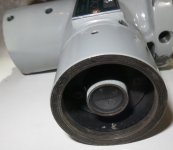rimcanyon
Diamond
- Joined
- Sep 28, 2002
- Location
- Salinas, CA USA
I have attached photos of a K&E part that I would like to identify. It is not in any of my K&E optical catalogs. It is a right angle projection eyepiece assembly for an autocollimator. It has a reticle built-in. The optical micrometers measure angles of deviation, not displacement. They have an unusual feature: a rev counter, that extends the range of each micrometer to 20 minutes of arc. The dial has threads on the edge that engage the teeth on the rev counter.
I would like to know which instrument this is designed to fit (e.g. the 4210, except that the built-in reticle would not make sense in that case?). It is from NASA and probably dates back to the Apollo project. I checked with Brunson and was told that the majority of K&E knowledge stayed on the east coast, rather than move to Kansas City when Brunson acquired K&E/Cubic.
Dave
I would like to know which instrument this is designed to fit (e.g. the 4210, except that the built-in reticle would not make sense in that case?). It is from NASA and probably dates back to the Apollo project. I checked with Brunson and was told that the majority of K&E knowledge stayed on the east coast, rather than move to Kansas City when Brunson acquired K&E/Cubic.
Dave









